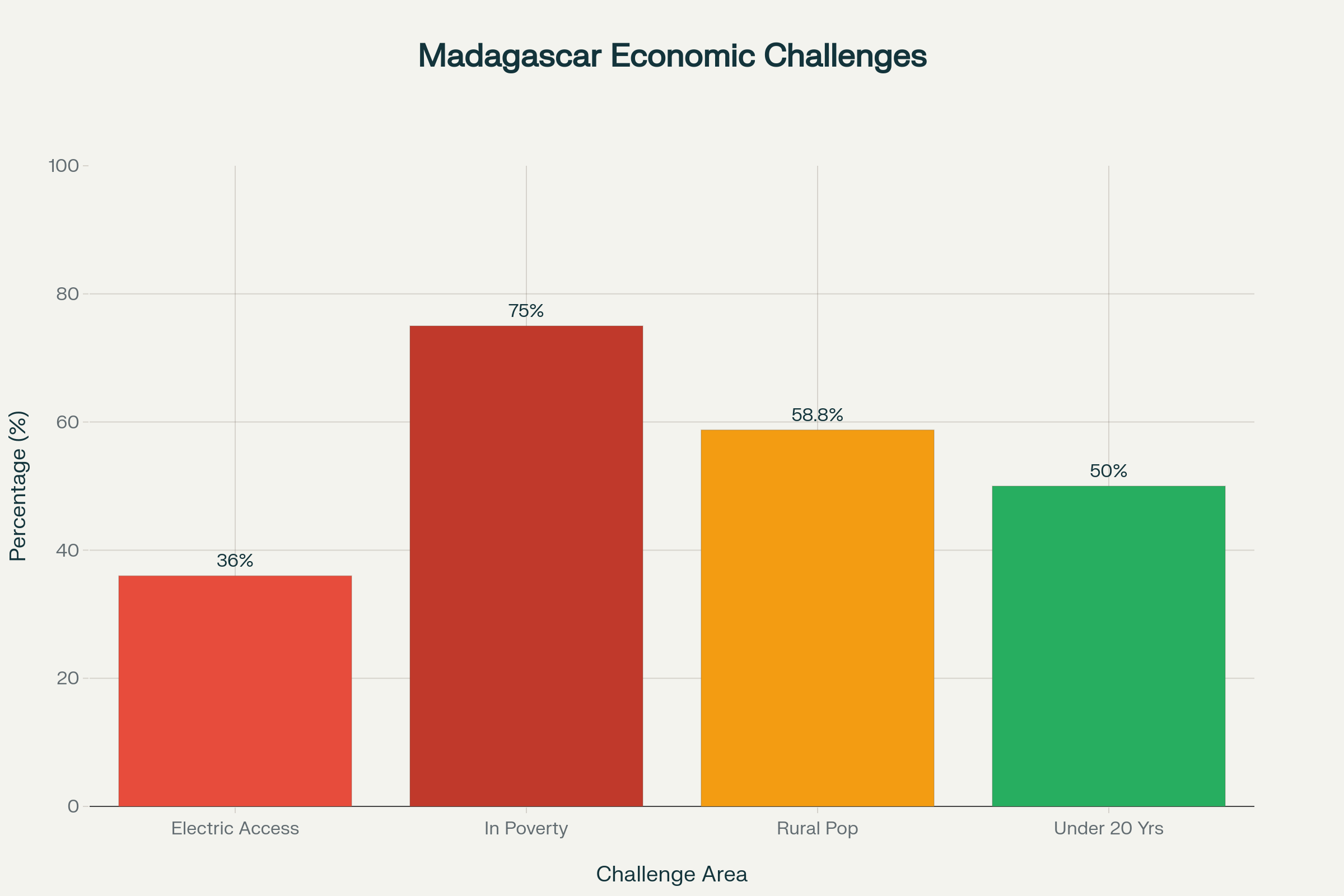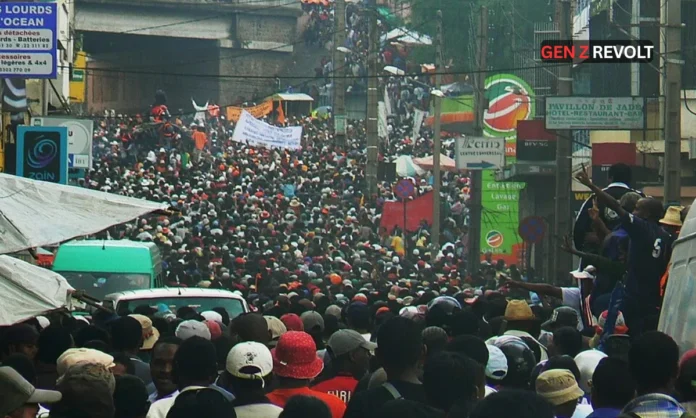Key Highlights
- Madagascar Gen Z protests originated from chronic water and electricity shortages affecting 75% of the population living below the poverty line
- Elite CAPSAT military unit joined protesters, forcing President Rajoelina to flee the country via French military aircraft
- At least 22 protesters died in clashes with security forces during three weeks of demonstrations across major cities
Opening Overview
The Madagascar Gen Z protests represent the latest chapter in a global wave of youth-led political movements that have successfully challenged established governments from Bangladesh to Nepal. What distinguishes the Madagascar Gen Z protests from previous uprisings is the unique alliance between young demonstrators and an elite military unit that ultimately forced a sitting president into exile.
The protests erupted on September 25, 2025, initially focused on the government’s failure to provide reliable electricity and water services to Madagascar’s 30.3 million citizens. However, the Madagascar Gen Z protests quickly expanded beyond infrastructure grievances to encompass broader issues of corruption, economic inequality, and political nepotism that have plagued the Indian Ocean island nation for decades.
With only 36% of Madagascar’s population having access to electricity according to International Monetary Fund data, and frequent power cuts exceeding eight hours daily, the Madagascar Gen Z protests tapped into deep-seated frustrations among the country’s predominantly young population. The median age of Madagascar’s population is under 20 years, creating a demographic powder keg that the Madagascar Gen Z protests successfully mobilized into political action.
The movement gained unprecedented momentum when Madagascar’s elite CAPSAT military unit, the same force that brought Rajoelina to power in 2009, switched sides to support the Madagascar Gen Z protests on October 12, 2025.
Youth Movement Emerges from Infrastructure Crisis
The Madagascar Gen Z protests began as spontaneous demonstrations against chronic utility failures that have plagued the nation for years. Citizens reported going without running water for six years while continuing to pay for services, creating the perfect conditions for the Madagascar Gen Z protests to gain widespread support.
- Electricity access remains limited to just 36% of the population according to IMF statistics
- Power outages frequently exceed eight hours daily, severely impacting daily life and economic productivity
- Water shortages force residents to queue at dawn for basic supplies, with service interruptions lasting days
Twenty-two-year-old hotel worker Fanomeantso told Reuters his monthly salary of 300,000 ariary (approximately $67) barely covered food expenses, exemplifying the economic grievances driving the Madagascar Gen Z protests. The state-owned utility company JIRAMA has struggled with inefficient production, high transmission losses, and tariffs below recovery costs, creating a substantial fiscal burden that undermines government investment in social services.
The Madagascar Gen Z protests initially attracted hundreds of participants in Antananarivo, the capital city, where demonstrators carried yellow jerrycans and tin-can lamps as symbols of resistance against utility failures. These protests quickly spread to other major cities including Toliara and Diego Suarez, demonstrating the nationwide scope of discontent that would fuel the Madagascar Gen Z protests.
Student Sarobidy Ramarimanana, 22, described the daily struggle of fetching water in darkness during power outages, asking “How can they expect us to remain quiet?” This sentiment captured the broader frustration that transformed localized infrastructure complaints into the comprehensive political movement known as the Madagascar Gen Z protests.

Madagascar’s Socioeconomic Challenges Driving Gen Z Protests
Military Alliance Transforms Political Landscape
The Madagascar Gen Z protests achieved unprecedented success when the elite CAPSAT military unit joined demonstrators on October 12, 2025, fundamentally altering the political dynamics of the uprising. CAPSAT, an acronym for Corps d’administration des personnels et des services administratifs et techniques, had previously brought Rajoelina to power during the 2009 coup, making their support for the Madagascar Gen Z protests particularly significant.
- CAPSAT soldiers escorted youth protesters to May 13 Square in Antananarivo, the main protest venue
- The military unit appointed General Demosthene Pikulas as new chief of staff, accepted by government officials
- Colonel Michael Randrianirina denied conducting a coup, stating they had only “answered the people’s calls”
The alliance between CAPSAT and the Madagascar Gen Z protests emerged after security forces killed at least 22 protesters using tear gas, rubber bullets, and stun grenades to disperse crowds. United Nations High Commissioner for Human Rights Volker Türk condemned the “violent response” to the Madagascar Gen Z protests, calling for respect of freedom of expression and peaceful assembly.
CAPSAT’s intervention came after one of its soldiers was reportedly shot dead by gendarmerie forces during the Madagascar Gen Z protests, creating the catalyst for military involvement. Colonel Randrianirina, who had previously spent months in prison in 2023 for allegedly attempting a coup against Rajoelina, emerged as the key military figure supporting the Madagascar Gen Z protests.
The military’s decision to support the Madagascar Gen Z protests rather than suppress them marked a crucial turning point that distinguished Madagascar’s uprising from other youth movements worldwide. By Saturday, October 12, crowds were cheering for Randrianirina and CAPSAT members as they marched through Antananarivo streets, transforming the Madagascar Gen Z protests into a celebration of political change.
Presidential Flight and Government Collapse
President Andry Rajoelina’s response to the Madagascar Gen Z protests ultimately precipitated his own downfall and flight from the country. Initially attempting to appease protesters by dismissing Prime Minister Christian Ntsay and his entire cabinet on September 29, Rajoelina’s reforms failed to satisfy the demands of the Madagascar Gen Z protests for his complete removal from power.
- Rajoelina fled Madagascar on October 13 via French military aircraft, according to diplomatic sources
- Parliament voted to impeach the president with 130 votes in favor and one blank vote
- The African Union suspended Madagascar and condemned the unconstitutional change of power
The Madagascar Gen Z protests reached a critical juncture when Rajoelina appointed Major General Ruphin Zafisambo as the new Prime Minister on October 6, a decision that further inflamed protesters who viewed the military appointment as maintaining the status quo. From an undisclosed location, Rajoelina claimed that “a group of military personnel and politicians” planned to assassinate him, stating “I was forced to find a safe place to protect my life.”
The final blow to Rajoelina’s presidency came when parliament moved to impeach him on October 14, despite his attempt to dissolve the lower house earlier that day. The legislative body ignored Rajoelina’s dissolution order and proceeded with the impeachment vote, demonstrating the complete erosion of his political authority in the face of sustained Madagascar Gen Z protests.
Colonel Randrianirina announced he was “taking the position of president” in an interview with The Associated Press, promising elections within two years while maintaining that the transition resulted from popular demand rather than a military coup. The swift collapse of Rajoelina’s government, despite his initial rise to power through similar protests in 2009, illustrates the transformative power of the Madagascar Gen Z protests in reshaping the nation’s political landscape.
Regional Context and Global Gen Z Movement
The Madagascar Gen Z protests form part of a broader pattern of youth-led political movements that have successfully challenged governments across multiple continents in 2025. Similar to recent uprisings in Bangladesh and Nepal, the Madagascar Gen Z protests demonstrate how infrastructure failures and economic hardship can rapidly evolve into comprehensive demands for political change.
- Madagascar becomes the second government toppled by Gen Z protesters in recent weeks
- Youth movements have adopted common tactics including social media organization and symbolic protests
- Economic inequality and perceived government corruption serve as consistent catalysts across different nations
The Madagascar Gen Z protests share striking similarities with Bangladesh’s successful youth uprising that removed Prime Minister Sheikh Hasina from power in August 2025. Both movements began with specific grievances—job quotas in Bangladesh, utility failures in Madagascar—but quickly evolved into broader anti-government campaigns that ultimately achieved their primary objective of leadership change.
What distinguishes the Madagascar Gen Z protests is the unique alliance with military forces that historically supported the existing government. While other Gen Z movements have faced violent suppression by security forces, the Madagascar Gen Z protests benefited from CAPSAT’s decision to support rather than oppose the demonstrators, creating an unprecedented coalition for political change.
The international response to the Madagascar Gen Z protests has been mixed, with the African Union condemning the “unconstitutional change of power” and suspending Madagascar from the organization. However, the United Nations has focused primarily on condemning the violent response to protesters rather than the ultimate political outcome, suggesting tacit recognition of the legitimate grievances driving the Madagascar Gen Z protests.
The success of the Madagascar Gen Z protests reinforces the growing influence of youth-led movements in global politics, particularly in nations with young populations facing economic hardship and governance failures. As Madagascar transitions to military leadership with promises of elections within two years, the long-term impact of the Madagascar Gen Z protests on democratic governance and youth political participation remains to be determined.
Final Perspective
The Madagascar Gen Z protests have achieved what seemed impossible just weeks ago: the complete overthrow of an established government through a combination of sustained youth activism and strategic military alliance. The movement’s success in forcing President Rajoelina into exile demonstrates the transformative potential of the Madagascar Gen Z protests when basic governance failures meet organized popular resistance.
The rapid evolution from infrastructure complaints to presidential flight illustrates how the Madagascar Gen Z protests tapped into fundamental contradictions in Madagascar’s political economy, where 75% of citizens live in poverty while political elites maintain power through military backing. The irony that CAPSAT, the same unit that brought Rajoelina to power in 2009, ultimately supported the Madagascar Gen Z protests that forced his exile, highlights the unpredictable dynamics of political change in contemporary Africa.
As Colonel Randrianirina assumes presidential powers with promises of civilian government and future elections, the ultimate success of the Madagascar Gen Z protests will depend on whether the movement’s demands for improved governance and basic services are translated into concrete policy changes. The Madagascar Gen Z protests have proven that sustained youth mobilization can topple governments, but the harder task of building responsive institutions remains ahead for Madagascar’s young population.


